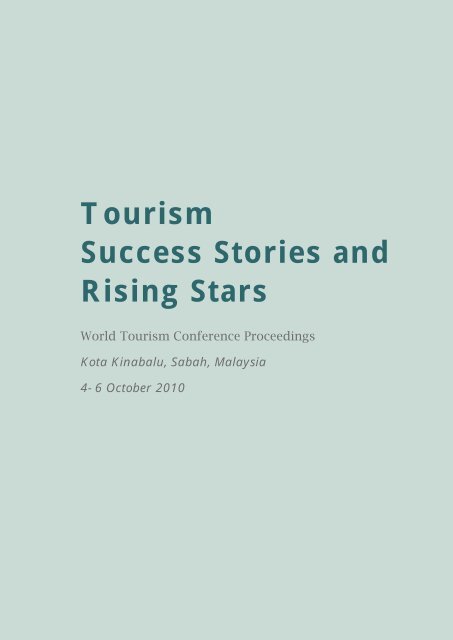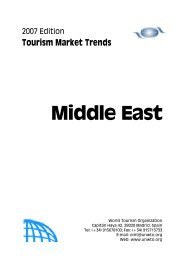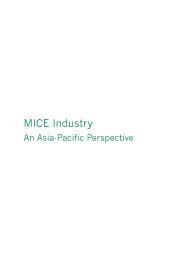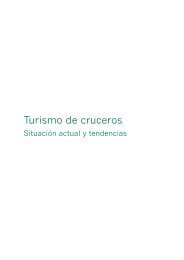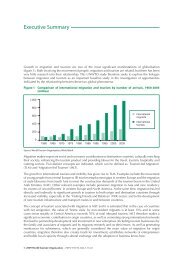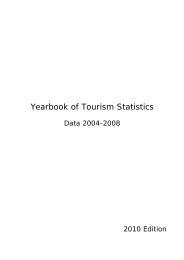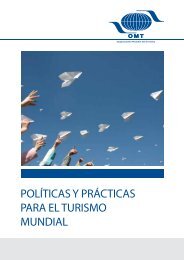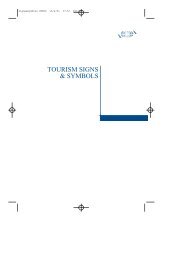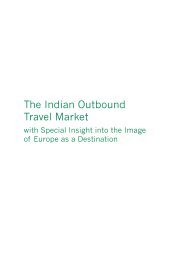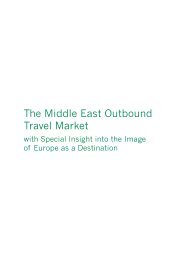View PDF Excerpt - World Tourism Organization UNWTO
View PDF Excerpt - World Tourism Organization UNWTO
View PDF Excerpt - World Tourism Organization UNWTO
Create successful ePaper yourself
Turn your PDF publications into a flip-book with our unique Google optimized e-Paper software.
Table of ContentsForeword ............................................................................................................... v1. Overwiew .............................................................................................................. 1Datuk Dr. Victor Wee and Dr. Wong Kong Yew2. Papers and Presentations .............................................................................. 192.1 Opening Ceremony ......................................................................................... 192.1.1 Welcome Remarks ............................................................................... 21The Hon. Dato’ Sri Dr. Ng Yen YenMinister of <strong>Tourism</strong>, Malaysia2.1.2 Welcome Remarks ............................................................................... 25The Right Hon. Datuk Seri Panglima Musa Haji AmanChief Minister of Sabah2.1.3 Welcome Remarks ............................................................................... 27His Excellency Mr. Taleb RifaiSecretary-General, <strong>World</strong> <strong>Tourism</strong> <strong>Organization</strong> (<strong>UNWTO</strong>)2.2 Keynote Speeches ............................................................................................ 332.2.1 Country Branding for Sustainable Success .................................... 35Susan Warren2.2.2 Shaping the Government Agendato Improve <strong>Tourism</strong> Competitiveness ............................................ 55Dr. Jurgen Ringbeck2.2.3 Running a Successful National <strong>Tourism</strong> Campaign:Visit Malaysia Year 2007 .................................................................... 71Datuk Dr. Victor Wee and Dato’ Dr. Ong Hong Peng
Foreword<strong>Tourism</strong> has proven over the years to be a great contributor to the global economy.It is a powerful driver of socio-economic growth and progress as evidenced by thecreation of jobs and enterprises, infrastructure development and the generation offoreign exchange income.Even though it is not immune to the influence of crisis situations of national, regionalor international nature, it has also repeatedly demonstrated its ability to reboundstrongly after crisis.The <strong>World</strong> <strong>Tourism</strong> Conference (WTC) 2010 was organised at a time when the tourismindustry was gradually recovering from the exceptionally challenging time it hadexperienced under the influence of the global economic crisis. This was no coincidence.<strong>UNWTO</strong>’s response to the global economic challenge and its negative impact oninternational tourism was to design a Roadmap for recovery. It is a testament totourism and travel as one of the world’s biggest sources of employment and exportearnings as well as a crucial catalyst for economic recovery. In line with the Roadmap,WTC 2010 aimed at examining the strategies of leading destinations and organisationswhich can be adopted to accelerate growth in the tourism industry. It also focusedon innovative product development and marketing strategies for tourism to enablepublic and private sectors to harness and maximise the potential of tourism.<strong>Tourism</strong> Success Stories and Rising Stars – the end-product of the Conference is acompilation of examples of success stories and best practices of leading destinationsand organisations in the tourism industry. It covers topics ranging from the creationof tourism businesses, service excellence, country branding to tourism productdevelopment and marketing.I congratulate all the international speakers and experts as well as their localcounterparts from Malaysia whose valuable contribution of information has enrichedForeword • v
the contents of the publication. It is a must-have reference material which we areadding to the pool of knowledge on tourism business operations, tourism policies,strategies and methodologies for tourism development at the national, regional andmunicipal levels.I also commend Dr. Victor Wee, Chairman of <strong>UNWTO</strong>’s Programme Committee andDr. Wong Kong-Yew, Associate Professor of the <strong>Tourism</strong> Research Institute for PolicyStudies of Malaysia for their contribution to the conclusions of the publication as wellas their editorial input.Last but not least, I compliment the Regional Programme for Asia and the Pacific of<strong>UNWTO</strong> on initiating and coordinating the production of this publication.Taleb RifaiSecretary-General<strong>World</strong> <strong>Tourism</strong> <strong>Organization</strong> (<strong>UNWTO</strong>)vi • <strong>Tourism</strong> Success Stories and Rising Stars
1Overview
Datuk Dr. Victor WeeChairman, Malaysia <strong>Tourism</strong> Promotion BoardDr. Wong Kong YewVice President, Strategic Projects, UCSI UniversityThe <strong>World</strong> <strong>Tourism</strong> Conference 2010 (WTC2010) held from 4 to 6 October 2010 inKota Kinabalu, state capital of Sabah, Malaysia was very timely because it provideduseful inputs to governments and the tourism industry that were looking for ways toboost the economy and businesses following the 2009 economic slump. The tourismand travel industry is now gaining more attention as a generator for income andemployment. To mainstream tourism in the economic agenda, the <strong>World</strong> <strong>Tourism</strong>Organisation (<strong>UNWTO</strong>) and the <strong>World</strong> Travel and <strong>Tourism</strong> Council (WTTC) are bothcollaborating on a campaign to raise the profile of tourism by meeting with heads ofstates and impressing on them the importance of this industry.As mentioned by Dr. Taleb Rifai in his Welcome Remark in the <strong>World</strong> <strong>Tourism</strong>Conference 2010 (WTC2010), sustaining growth in the difficult world-trading climateis a challenge. Adding to the issues faced by the tourism industry, Rifai said thatthe economy, employment, enablement, environment and energy are currently theindustry’s biggest challenges. The austerity measures, as well as the rise in taxationon travel implemented by several advanced economies, are expected to negativelyimpact the leading outbound markets. Of concern are governments – in particularthe United Kingdom and Germany – taxing outbound tourism as a source of revenuewhich has been disguised as taxes to reduce airline emissions. For tourism to prosperand deliver its full range of benefits, including generating employment, governmentsneed to adopt enabling environments in terms of tourism facilitation policies andenabling legislative environments.Yet, as the world grows smaller, the competition for tourism businesses is heatingup. Unforeseen occasional shocks could adversely affect a country’s tourism industryand even set back its entire economy (Ringbeck and Gross, 2007). Hence, there is aquestion on what countries can do to sustain and improve their tourism industry.WTC2010 brought together an impressive panel of speakers who represents aselection of the “Stars” from the tourism industry, addressing the issue of how toOverview • 3
enhance one’s competitiveness and grow the tourism industry at different levels,specifically the national, city, destination and corporate levels. To bring about growthin this industry that cuts across sectors, government bodies, private sectors andNGOs should collaborate and cooperate to promote and sustain development of thetourism industry. Public-Private Partnership (PPP) is one of the most popular practicesadopted by various destinations to enhance their competitive advantage.<strong>Tourism</strong> as an economic contributorThe growth of tourism industry globally in the past few decades has made significantcontributions to economic growth and employment generation. According to the<strong>UNWTO</strong> <strong>Tourism</strong> Highlights 2011, the overall income derived from inbound tourism in2010 exceeded US$ 1 trillion, or close to US$ 3 billion a day. <strong>Tourism</strong> earnings whichare regarded as export of services also account for as much as 30% of the world’sexport of commercial services and 6% of the overall export of goods and services in2010. It is ranked fourth after fuels, chemicals, and automobile products in the globalexport category. <strong>Tourism</strong>’s contribution to worldwide GDP is estimated at 5%, withfigures ranging from 2% for countries where tourism is a comparatively small sectorto over 10% for countries where tourism is an important pillar of the economy. Thecontribution of tourism to employment tends to be slightly higher and is estimated inthe order of 6-7% of the overall number of direct and indirect jobs worldwide.Despite the occurrence of occasional shocks, international tourist arrivals have showna strong growth trend, from 675 million in 2000 to 940 million in 2010. Tourist flowstend to be more rapid in the emerging and developing countries where their shareof arrivals have steadily risen, from 31% in 1990 to 47% in 2010 (<strong>UNWTO</strong> <strong>Tourism</strong>Highlights 2011). This massive number of tourists trotting the globe annually forpleasure has important implications and effects on the economies, infrastructuresand governmental policies of the countries to which they travel.<strong>Tourism</strong> is also recognised for its contribution to reducing poverty and preservingnatural and cultural resources in nations across the world. It has not only encouragedgrowth in the hospitality and related industries of many countries, but also led to thedevelopment of infrastructure to access the natural as well as man-made attractionswhich benefit both the tourists and the local residents.4 • <strong>Tourism</strong> Success Stories and Rising Stars
Attitudes and recognition of countries on tourismas an economic mechanismMany governments all over the world have acknowledged tourism as one of themechanisms to stimulate economic development, accelerate local investment andboosting employment. The Travel and <strong>Tourism</strong> Growth-Policy Risk Matrix (Ringbeckand Gross, 2007) is helpful for governments to review and examine the operationand performance of individual and aggregate rankings in their countries. The Traveland <strong>Tourism</strong> Growth-Policy Risk Matrix was created by combining the Travel and<strong>Tourism</strong> competitiveness index and the tourism satellite account outlook for growth.The matrix can be used to assess business units or product lines, and how best toallocate resources on an international basis. Figure 1 shows a growth-policy riskmatrix of whose results are classified in Cash Cow, Dogs, Question Marks, and Stars.The explanation of each of these categories is shown in Table 1. The success storiespresented in WTC2010 fall within the northeast quadrant.However, the intention of using the matrix is not to suggest that enterprises shouldstrive to achieve a balance of businesses across all four quadrants. Rather, the matrixallows the industry to begin addressing how it wishes to proceed in terms of currentoperations and the direction for possible future investments. Countries can alsofigure out what they want their future tourism industry to look like.Figure 1 Travel and <strong>Tourism</strong> Growth-Policy Risk MatrixSource: Miller, 2007 in Travel and <strong>Tourism</strong> Competiveness Index ReportOverview • 5
Table 1 Travel and <strong>Tourism</strong> (T&T) Growth-Policy Risk Matrix Public-Private Partnership (PPP)Cash CowsDogsQuestion MarksStarsCharacteristics Ways to move forward Aspiration– Countries with low policy – Satisfied with policyStarsrisk and slow T&T economy. situation but unsatisfied– Companies in this group with outlook for growth.generate a return in excess – Should focus attentionof the amount of riskon incentives that willincurred by operating this encourage investment.country.– Countries with high policyrisk and slow T&T economy.– Companies in this grouptypically break even,although they generatebarely enough return tomaintain the risk/returnratio.– Countries with high policyrisk and fast growing T&Teconomy.– Require large amount ofinvestment and policyattention to decrease thepolicy risks.– Countries with low policyrisk and fast growing T&Teconomy.– Sustaining the country’spolicy leadership requiresextra attention.– Worried about policysituation and outlook forgrowth.– Should prioritise byfocusing on policy issueswith the greatest return oninvestment.– Public sector should reducethe risk in a return-oninvestmentapproach.– In order to maintain highlevel of growth, significantattention to details andworking with privatesector to understand theirneeds are required beforetranslating this informationinto policy initiatives thatwill keep a country ahead ofa curve.Question Marksor Cash CowsStarsA growing number of studies and articles offer evaluations of public-privatepartnerships in a broad range of theory and policy areas. In tourism, the issue ofparticipation and stakeholders’ involvement in development has been addressed todatein the context of National <strong>Tourism</strong> Administrations (WTO, 1996). A successfulmodel for PPP is acknowledged by tourism destinations as a key driver for tourismresilience. The most common types of PPP that have been identified by the majorityof the destinations are those related with marketing and promotion activities and thedevelopment of new products and services (<strong>UNWTO</strong>, 2009).PPP is activated when specific challenges need to be addressed, or opportunities needto be unlocked, which clearly require the support of both parties. These will be shown6 • <strong>Tourism</strong> Success Stories and Rising Stars
in Table 2 below. Therefore, it is suggested that PPP will enhance the competitiveadvantage of tourism industry in a particular destination or destinations. It willprovide viable and alternative efficient and effective delivery of tourism products,infrastructure facilities and added value, through collaboration and partnershipsbetween various key stakeholders from the demand and supply side.Table 2 Requirement of the Government and Private sectors for Competitive AdvantageGovernment’s needsSpecific skills or expertisefor implementationCapital investmentRisk managementAccelerated deliveryBudget leverageIndustry advantagePrivate sector’s needsPlanning permissionFundingIncentivesPolicy modificationLobbying supportElimination of red tapeSource: Compass, 2010The concept of competitiveness and competitive advantage has been attractingenormous attention from scholars in business and international trade. Hence, thecompetitiveness of tourism destinations is also of interest to all stakeholders in theindustry. Literature on competitiveness has been reviewed extensively. The principalhallmarks of this literature centre on theories of international trade and on thecontemporary work by Michael Porter on competition among firms and among nations(Crouch and Ritchie, 1995). Porter’s diamond model (1991) shows four determinantsof national advantage which will affect its ability to compete: (1) factor conditions– the necessary resources are readily available or easy to source through globalnetworks, (2) demand conditions – home demand which plays a disproportionate rolein influencing the perception of buyer needs and the capacity of firms to improveproducts and services over time, (3) firm strategy, structure, and rivalry – the contextfor competition in a region or nation, and (4) related and supporting industries – theavailability, accessibility and presence of local suppliers in related fields and the roleof government policy.The contribution of partnerships to the competitive advantage of tourism destinationscan be summed up by the tentative destination competitiveness model of Crouch andRitchie (1995). The model includes four groups of factors (Figure 2). The core groupOverview • 7
epresents factors which act to attract tourism. It includes tourism resources suchas biological, ecological, cultural and social resources, as well as attractions, festivalsand events, and man-made superstructures. A destination can identify its competitiveadvantage in terms of pull factors, and which factor will capture tourists’ attentionand make it stand out compared to other destinations. This is a fundamental fortourism planning and developing.Figure 2 Tentative Destination Competitiveness ModelSource: Crouch and Ritchie, 1995Supporting factors provide the foundations for a strong tourism operation. Sincetourism is considered a cross-sectional industry, availability and support fromrelated industries suppliers will provide advantages in terms of information, accessto new technology, and market penetration. Therefore, competitive advantage is alsoaffected by the presence of local suppliers and related industries in those products,machines or services that are essential to the process of innovation. This also refersto forward and backward linkages in the tourism industry where an enterprise systemis an engine for free enterprise economics, accounting for employment and output,especially small and medium enterprises (SMEs). SMEs are the greatest source for newideas and inventions. Therefore, tourism SMEs are of fundamental importance to thedevelopment of tourism as an industry.8 • <strong>Tourism</strong> Success Stories and Rising Stars
One of the most important influencing factors for competitive advantage is government.The key role of government in tourism policy is undeniable, even though tourism is aprivate sector-driven industry. Government bodies at all levels can improve nationaladvantage by their investment schemes, which influence the goals of individuals andfirms (Porter, 1991). Government policies that succeed are those which create anenvironment in which companies can gain competitive advantage (Porter, 1991).A further factor which influences a destination’s competitive potential, is destinationequity (Wong, 2004) which is considered as tourist perception of a destination, basedon social, economical, environmental, and infrastructure development, and politicalstability. This global force is not only important to attract tourists and travellers butalso draws interest and business opportunity from investors.Destination management factors represent the destination’s ability to shape andinfluence its competitive strength (Crouch and Ritchie, 1995). It can include businesspermits and zoning controls, research and development work, marketing strategyand promotion, business association initiatives and a host of other techniques toshape the service integrity and productivity.The approachThe main thrust of this conference was to uncover the ‘secrets’ of leading destinationsand organisations in the tourism industry and provide invaluable lessons on howto achieve growth and competitiveness in the tourism industry in an increasinglychallenging and competitive global environment. The conference was targeted atgovernment officers and policy makers involved in managing and promoting tourismgrowth, as well as industry leaders and practitioners who were seeking a greaterunderstanding of current market trends. It provided an understanding of tourismdestination management and marketing, and generated ideas on how to synergizecorporate strategies with government initiatives to obtain optimum benefits for allthe parties involved.The conference featured three keynote speeches and three thematic sessions in orderto provide an opportunity to industry stakeholders to learn on a first-hand basis fromthe success stories, perspectives and experiences. The keynote speeches touch onOverview • 9
the issue of branding and managing reputations for countries and destinations, themacroeconomic reality and growth in regional travel that shape government traveland tourism agenda, and Malaysia’s big success in running a year-long campaign onVisit Malaysia Year 2007.The first session focussed on Mega Trends and Innovation and how they impact onstakeholders in carrying out their business in the competitive world. The innovativeapproach adopted by Air Asia X was excellent example of how a low-cost carrierachieved success by riding the trend for passenger traffic. Cities being major touristdestinations could be rated for global competitiveness in order to evaluate theircapacity to sustain strong visitor flows.The theme for the second session was <strong>Tourism</strong> Business and Service Excellence. TheCanadian <strong>Tourism</strong> Commission conducted an in-depth study of its best and worsttourism customers and turned that customer knowledge into more targeted campaignsand improved marketing performance for overall tourism competitiveness. Twocases were presented in this session. The first was on running a chain of Malaysianownedinternational luxury hotels, while the second was the experience of France inincreasing its already high tourist arrivals.In the third session, the presentations narrowed down to <strong>Tourism</strong> ProductDevelopment and Marketing. Levine argued the case of developing new tourismproducts and maximising the tourism potential by recognising global economic shiftsand changing consumer behaviour. Sabah had distinguished itself as a mega biodiversitydestination and showed how more value could be obtained from naturebasedtourism. For an established tourism destination such as Amsterdam, thechallenge was reinventing itself and creating new experiences for tourists so that theywould continue to return to the city as visitors.Keynote speechesImage building is a complex process, and no single organisation can control andcommunicate reputation. In her paper, Susan Warren argues that managing reputationfor countries and destinations is a powerful way to support success across the fourpillars of sustainability: economic, social and cultural, environmental, and climate10 • <strong>Tourism</strong> Success Stories and Rising Stars
change. There are multiple stakeholders, conflicting political agendas, and the privatesector which is mainly industry-driven, which do not engage enough to providestrategic inputs for successful national branding. Hence, country or destinationbranding must encompass a wider range of capabilities spanning across political,investment, business, tourism, culture and community. The collaboration andagreement with multiple stakeholders on a vision and national strategy is a mustfor country branding. For this reason, government, business and civil society shouldtake responsibility to lead and manage national reputation. Warren pointed out someexamples of successful brands that have been undertaken by India, South Africa,Australia and New Zealand. More and more countries are pursuing nation brandinitiatives for a more comprehensive approach to reputation management as well asproviding higher visibility to influence reputation.In his presentation, Jurgen Ringbeck, who was a Senior Partner in Booz & Company,highlighted four major drivers that will shape the global Travel and <strong>Tourism</strong> agenda:(1) new macroeconomic reality with high uncertainty, (2) increasing competitionthroughout the Travel and <strong>Tourism</strong> value chain, (3) the “typical” tourist is changing,and (4) sustainability will become a prerequisite for Travel and <strong>Tourism</strong>. He alsorecommended five considerations for policymakers to map out potential means toensure successful development under these new conditions: (1) fostering resilienceof the national Travel and <strong>Tourism</strong> sector against short-term disruptive events andexternal shocks, (2) ensuring easy access to national tourism offering, (3) refiningnational tourism strategies to cater to new or more attractive tourist segments,(4) implementing a more holistic view of Travel and <strong>Tourism</strong> economy as a whole, and(5) considering environmental sustainability as a major driver of future Travel and<strong>Tourism</strong> competitivenessA good case highlighting the collaborative effort in running a successful tourismcampaign was provided by the paper presented by Datuk Dr. Victor Wee (Chairman,Malaysia <strong>Tourism</strong> Promotion Board) and Dato’ Dr. Ong Hong Peng (Secretary General,Ministry of <strong>Tourism</strong> Malaysia) on how Malaysia had successfully put together apowerful campaign that encompassed branding, getting the resources and supportfrom multiple stakeholders’ collaboration, and obtaining strong government supportin developing and promoting tourism. The Visit Malaysia Year 2007 (VMY2007)campaign, which was mounted to mark Malaysia’s 50th year of Independence, wereaimed at showcasing to the world Malaysia’s achievements during the last 50 yearsOverview • 11
as well as revitalising and propelling tourism development in order to transformMalaysia into a tourism country.The presentation unveiled behind-the-scenes considerations and strategies that wereadopted to run a successful national campaign. In fact, it can be said that VMY2007was probably one of the most successful visit year tourism campaigns ever conducted.Through the campaign alone, Malaysia increased its arrivals by 3.5 million in 2007and raised its tourism receipts by US$ 3.3 billion. This campaign boosted Malaysia’sarrivals to 21 million and tourism receipts to US$ 15.4 billion and helped to propelMalaysia into the rank of the top ten most visited destinations three years later.We gave the arguments that were used to request for the budget to run the campaign.One perennial problem faced by tourism agencies was convincing the Ministry ofFinance to allocate sufficient resources to run a successful campaign. The Ministry of<strong>Tourism</strong> (MOTOUR) was able to put up a strong argument on how every ringgit thatwas allocated to run the campaign could bring in a return of RM100 in internationaltourism receipts for the economy. Another problem faced by MOTOUR was to get theother bigger ministries whose policy actions affect tourists to adjust and reorienttheir policies to become tourism-friendly. MOTOUR was instrumental in establishingthe Cabinet Committee on <strong>Tourism</strong>, comprising ministers from key agencies andchaired by the Deputy Prime Minister. As the secretariat, MOTOUR prepared paperswith recommendations on how to improve government policy measures for thegrowth of the tourism industry which led to the synchronisation of policy actions andcontributed to the success of VMY2007 campaign. Through coordination meetings,the various government agencies and the relevant industry players became clearabout their respective roles and functions which contributed to the success of thecampaign.Megatrends on travelOne prominent example of partnership in contributing to competitive advantage is astudy about top ten trends which will re-shape world tourism patterns in the next 20years. This study was a collaboration between Hong Kong Polytechnic University and<strong>UNWTO</strong> in order to identify major trends shaping tourism in Asia Pacific based uponcontent analysis of popular media in tourism. Professor Kaye Chon, Chair Professor12 • <strong>Tourism</strong> Success Stories and Rising Stars
and Director of the Hong Kong Polytechnic University, discussed some megatrendsoccurring within tourism and their implications on business practices. He alsoprojected future trends that would shape the future development of tourism businesspractices and outcomes.One of the prominent future trends pointed out by Chon was the rise of conscious (asopposed to ‘conspicuous’) consumption and stronger consumer awareness towardsresponsible tourism. Corporate social responsibility would encompass issues ofclimate change and global warming. Some future trends to look out for are hospitalityindustries offering environmentally friendly products and services, while long-haultravel will not be considered environmentally threatening as airlines opt for bio orrenewable fuel. There will be companies which would not sign contracts with hotelsthat do not have environmentally friendly features. There will also be rising demandfor medical tourism, sports tourism and soft adventure, as increasing longevitycreates new business opportunities. The pressure to remain competitive will make itnecessary for businesses to innovate and offer new vacation destinations, includingspace tourism.Professor Chon’s study pointed out that the centre of trade and travel will gravitatetowards Asia, while low-cost carriers will thrive, with the rising trend towards intraregionaltravel. Air Asia, one of the most successful low-cost airlines in the world,had capitalised on this megatrend. Most low-cost carriers would only concentrate onshort- and medium-haul routes, but Air Asia ventured into a new territory with theestablishment of Air Asia X, which flies long-haul routes that are dominated by legacyairlines. Instead of waiting for passengers to decide where they would like to go, AirAsia motivates consumers to purchase tickets at bargain prices without necessarilyknowing where they would be travelling to. It markets aggressively to convert interestinto purchase decisions through innovative campaigns and engaging the customerswith the brand. With low ticket prices and increased affordability of intra-regionaltravel, the trend for long-haul travel is towards a multi-destination experience.Concluding the topic on megatrends and innovation, Albert Stafford offered asystematic way in benchmarking and listing the performance criteria for cities whichwould like to be global tourism destinations in their own right. The performancemeasures include traditional elements such as visitor numbers, expenditure and lengthof stay, international events and MICE activities. In addition, there are also variousOverview • 13
measures such as product development and infrastructure, and the economic impactof visitor expenditure on employment. Cities aspiring to be globally competitive astourist destinations would need a highly transparent governance structure for citymanagement, efficient infrastructure and marketing approaches which stimulate newinvestments and create new attractions and experiences every few years. In addition,Stafford suggests the need for applying technology to provide high-quality visitorinformation and engaging with local communities for their support for tourismdevelopment and integration. The competitive global cities should adopt honestand accurate imagery, as well as recognise the mix of culture and the diversity oflocal cuisine which adds to the gastronomic experience. Marketing and promotionshould be undertaken as a clever partnership between government and industry withresponsibility not just falling to one or the other.<strong>Tourism</strong> business and service excellencePutting the customer at the centre of the marketing approach and understandingwhat they want is the key for successful destination marketing. William Hardingrelated how, when faced with keen competition, the Canadian <strong>Tourism</strong> Commission(CTC) had to take the step of learning more from Canada’s best and worst customersso as to turn that knowledge into its competitive advantage. Better knowledge of thecustomers would lead to more targeted campaigns, improved marketing performanceand lower marketing costs. The ‘Explorer Quotient (EQ)’ was developed to matchconsumers with tourism products based on travel values and motivations. Themarketing campaigns conducted by CTC using EQ and conversion studies helpedmarketers to achieve deeper consumer awareness and excellent results.For YTL Hotels, the development of the award-winning Pangkor Laut Resort on abeautiful tropical island set amidst the lush rainforest, was the result of passion,innovation and determination. James McBride mentioned that YTL adopted the peoplecentredand experience-based strategy in its chain of luxury hotels, ensuring that itsemployees understood consumer needs. To build its pool of quality manpower, YTLran its own hotel school in Kuala Lumpur to ensure that its employees had the righttalent and skills to do the job. For a hotel to be able to command premium rates, itmust have a beautiful destination and extraordinary staff who are engaged and ableto deliver quality service that meets the highest level of expectations.14 • <strong>Tourism</strong> Success Stories and Rising Stars
Zainal Adlin pointed out that Sabah is located at the apex of the coral triangle, and isthe world’s centre for marine diversity. Its diverse rainforest is over 130 million yearsold, more than twice the age of the Amazon. Nature products are fragile and havelimited carrying capacity. The approach adopted by Sabah is placing more emphasison yield rather than numbers and also being tourist- rather than product-centred.The secret of its marketing success is relationship-marketing, in which it engages instrategic networking and smart partnership with key players at all levels.Amsterdam is a mature destination for city tourism, and Han Dominicus said thatthe real challenge is developing new tourism products to attract more visitors whocome more often and spend more money. In its tourism product development, itconsiders visitor’s opinions through its surveys. Since Amsterdam is a small city,there are concerns about overcrowding. The plan was to spread out developmentout to the city centre in a polycentric pattern, with each area having its own identity,character and authenticity. New suburbs are developed so that visitors can experiencethe authentic way of life out of the city centre. The development of new areas withdifferent attractions will help to keep the tourists longer and encourage them tospend more.Conclusion<strong>Tourism</strong> is an important industry in Europe, although it is sometimes not perceivedas serious. This is unfortunate because tourism is an important economic pillar whichgenerates employment and supports a more diverse range of amenities. From thepaper presentations, it is clear that the government plays an important role in leadingand stimulating growth especially in emerging tourism industries and destinations.In addition, a strong collaborative mechanism for public-private sector partnershipis another important element for creating competitive advantage and success. Forcountries such as Malaysia, the tourism industry is the second largest source offoreign exchange and an important element in propelling economic growth. Malaysia’scompetitive tourism industry benefits from the strong government commitment tothis industry, and a plan is underway to take the industry further in the next 10 years.At the conference, many of the success stories that were shared had a commonthread, i.e. being alert to the changing trends, creative product development, and16 • <strong>Tourism</strong> Success Stories and Rising Stars
eing innovative in providing service excellence and experience. While the wealth ofexperiences and insights can be very useful in tourism planning, there is no magicbullet that could be used to propel a country, province, city or business to achievestar status. Some important lessons are: (1) learning to recognise consumer trendsand adjusting the business to take advantage of this; (2) government commitment todevelop and promote the tourism industry; (3) forging close working relationships atall levels of government as well as strong public-private sector partnership in runninga successful national or branding campaign; (4) establishing a strong brand imageand delivering the service quality that exceeds expectations; and (5) creativity andinnovation to be ahead of the game.BibliographyCompass (2010), PPP – Partnering for <strong>Tourism</strong> Growth, CNN’s TASK Group (online), available at: http://www.cnnmediainfo.com/task/download/TASK_Compass_19.pdfCrouch G. I. and Ritchie J. R. B. (1995), ‘Destination Competitiveness and the Role of the <strong>Tourism</strong>Enterprise’, Working Paper WP 95-19.Miller R. (2007), ‘Using Policy Measures and Economics to Improve Travel & <strong>Tourism</strong>–Related Policy andBusiness Decision Making’, in: <strong>World</strong> Economic Forum (2007), The Travel and <strong>Tourism</strong> CompetitivenessReport 2007: Further the Process of Economic Development, Geneva.Porter M. E. (1991), ‘Towards a Dynamic Theory of Strategy’, in: Strategic Management Journal, Vol. 12,pp. 95-117.Ringbeck Jurgen and Gross Stephan (2007), ‘Taking Travel & <strong>Tourism</strong> to the Next Level: Shaping theGovernment Agenda to Improve the Industry’s Competitiveness’, in: <strong>World</strong> Economic Forum (2007), TheTravel and <strong>Tourism</strong> Competitiveness Report 2007: Further the Process of Economic Development, Geneva.<strong>World</strong> <strong>Tourism</strong> <strong>Organization</strong> (2009), Impact of the Global Economic Crisis on Local <strong>Tourism</strong> Destinations,<strong>UNWTO</strong> Survey Report, <strong>UNWTO</strong>, Madrid.<strong>World</strong> <strong>Tourism</strong> <strong>Organization</strong> (2011), <strong>UNWTO</strong> <strong>Tourism</strong> Highlights, 2011 Edition (online), available at:www.unwto.org/facts (10-10-10).Wong K. Y. (2004), ‘Introducing <strong>Tourism</strong> Industrial Development Lifecycle Model: Productivity Spilloversas Essential Criteria for Sustainable Development’, in: Asia-Euro <strong>Tourism</strong>, page 2-13.Overview • 17


